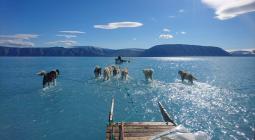Weatherwatch: Danube's ice cover changes are a warning in Hungary.

Scientists monitor frequency of Danube freezing over to track rising temperatures.
As a landlocked country in the heart of Europe, Hungary has a typically continental climate, with little or no influence from the sea. As a result, the climate is far more extreme than another European country on the same latitude, France.
The difference between typical temperatures in summer and winter can be as much as 30C, compared with a range of about 20 degrees in western France, and less than 10 degrees in the west of Ireland.
In July and August, temperatures regularly peak in the high 30s; while those in January and February often stay well below freezing. Rainfall is fairly evenly spread throughout the year, though with a slight peak in the late spring and summer months.
Snow often lies on the ground in winter, and the Danube, in the capital Budapest, used to freeze over regularly. However, during the past few decades this has happened far less often, as regional temperatures have risen due to the effects of the global climate crisis. Scientists are now using the changes in the ice cover on the Danube to track rising temperatures; and warn that although the lack of ice may be good news for the operators of river cruises, it sounds a timely warning for the rest of us.
24 August 2020
The Guardian







